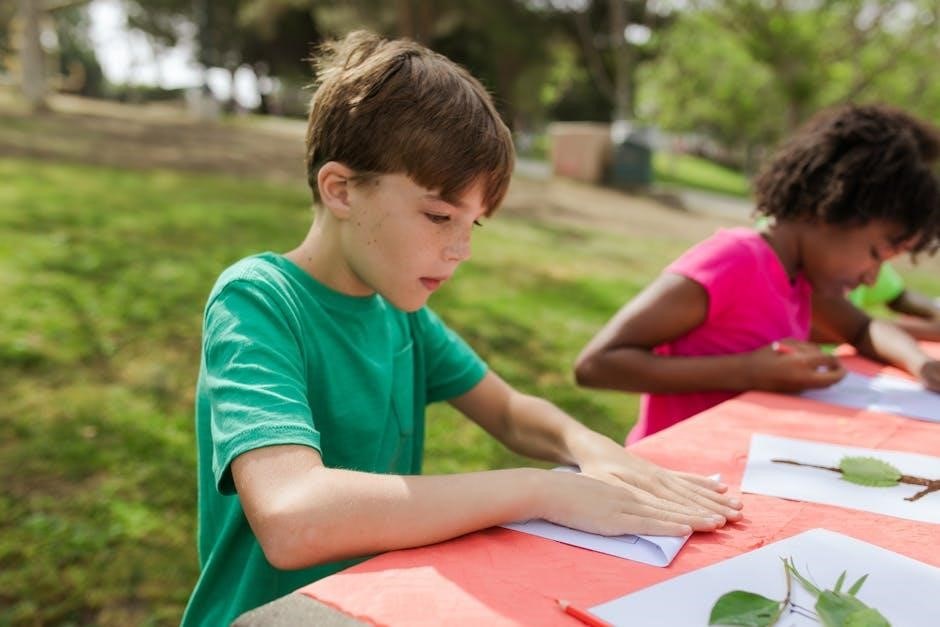A nature guide fosters a deeper connection with the outdoors, helping users explore, appreciate, and conserve the natural world through practical tips and insightful information.
1.1 Understanding the Purpose of a Nature Guide
A nature guide serves as an essential tool for exploring and understanding the outdoors, providing detailed information on local flora, fauna, and ecosystems. Its purpose is to educate users about conservation, safety, and sustainable practices while fostering a deeper appreciation for nature. By offering practical tips and insights, it helps individuals connect with their surroundings and enhance their outdoor experiences responsibly.
1.2 Importance of Connecting with Nature
Connecting with nature enhances mental and physical well-being, offering therapeutic benefits and a sense of calm. It fosters creativity, improves focus, and strengthens overall health. By immersing ourselves in natural environments, we cultivate a deeper appreciation for ecosystems, promoting environmental stewardship and sustainable living. This connection also supports personal growth, encouraging mindfulness and a greater understanding of our place within the natural world.
Preparation for Exploring Nature
Preparing for nature exploration involves planning, researching the terrain, and packing essential gear like sturdy footwear, waterproof clothing, and navigation tools to ensure a safe and enjoyable experience.
2.1 Choosing the Right Gear and Clothing
Choosing the right gear and clothing is essential for a comfortable and safe nature experience. Opt for sturdy footwear, breathable fabrics, and layers for varying weather conditions. Include essentials like a backpack, water bottle, and navigation tools. Don’t forget accessories such as hats, gloves, and sunscreen. Always check the weather forecast and pack accordingly to ensure preparedness for any situation.
- Sturdy, waterproof footwear for terrain adaptability.
- Breathable fabrics like merino wool for temperature regulation.
- Water-resistant jacket and pants for unpredictable weather.
- Essential accessories: hat, gloves, and UV protection.
2.2 Essential Tools for Navigation
Navigating nature requires the right tools to stay on track. A detailed topographic map and a reliable compass are indispensable. Consider a GPS device for precise location tracking, especially in remote areas. Always carry extra batteries and know how to use your tools before heading out. Additionally, a whistle and flashlight can be lifesavers in emergencies. Learn to use natural cues like the sun’s position for direction.
- Topographic map for terrain awareness.
- Baseplate compass for accurate bearings.
- GPS device with extra batteries.
- Whistle for signaling help.
- Flashlight for low-light conditions.

Safety in Nature
Exploring nature safely requires preparation and awareness. Research the terrain, inform someone of your plans, and carry essentials like water, a map, and a first-aid kit.
- Plan routes and share itineraries.
- Stay informed about weather conditions.
- Be mindful of wildlife and hazards.
3.1 First Aid and Emergency Preparedness
A well-stocked first aid kit is essential for outdoor adventures. Include bandages, antiseptics, pain relievers, and any personal medications. Always carry a phone, map, and emergency shelter. Know basic first aid techniques for cuts, burns, and broken bones. Stay calm in emergencies and have a plan for quick evacuations if needed. Preparation ensures safety and confidence in nature.
3;2 Recognizing and Avoiding Natural Hazards
Check weather forecasts and trail conditions before heading out. Recognize signs of hazards like fast-rising rivers or unstable rocks. Use maps to avoid steep cliffs or landslide-prone areas. Stay on marked trails and watch for wildlife. Carry a first aid kit and know basic emergency protocols. Be prepared to adapt plans if conditions change, ensuring a safe and enjoyable outdoor experience.

Understanding the Natural Environment
Explore the intricacies of ecosystems, biodiversity, and conservation to foster a deeper appreciation of nature and promote sustainable practices for future generations.
4.1 Identifying Local Flora and Fauna
Identifying local flora and fauna is crucial for understanding biodiversity. Use field guides, apps, or consult experts to recognize species accurately. This knowledge enhances appreciation and supports conservation efforts.
Responsible observation ensures minimal disturbance to ecosystems. Learning about native plants and animals fosters a deeper connection to the environment and promotes sustainable interactions with nature.
4.2 Basics of Ecology and Ecosystems
Ecosystems are complex networks of living organisms (biotic) and non-living elements (abiotic) interacting in a specific environment. Understanding ecology helps us appreciate how plants, animals, and microorganisms depend on each other and their surroundings.
Key concepts include food chains, energy flow, nutrient cycles, and biodiversity. Healthy ecosystems maintain balance, supporting life and providing essential services like clean water and air. Conservation efforts protect these systems for future generations.
Outdoor Skills and Activities
Mastering outdoor skills like camping, hiking, and building shelters enhances your nature experiences. These activities connect you with the environment while fostering self-reliance and adventure.
5.1 Setting Up Camp and Building Shelters
Setting up camp and building shelters are essential outdoor skills for nature enthusiasts. Start by choosing a flat, dry spot for your tent. Use sturdy poles and secure stakes to ensure stability. For shelters, consider natural materials like branches and leaves or opt for a tarpaulin. Always prioritize safety and durability, ensuring your setup can withstand weather conditions. Practice makes perfect in mastering these techniques.
5.2 Starting a Campfire Safely
Starting a campfire safely begins with choosing the right tools and materials. Gather dry wood, kindling, and tinder, ensuring they are free from moisture. Clear the area of leaves and debris to prevent accidental spread. Build the fire in a designated pit or ring, away from flammable objects. Light the fire with matches or a lighter, gradually adding larger logs. Monitor the fire, keep water nearby, and fully extinguish it before leaving the site.

Capturing Nature’s Beauty
Capturing nature’s beauty involves observing and documenting its essence through photography, journaling, or art, using techniques that highlight light, color, and composition to preserve memorable moments.
6;1 Photography Tips for Landscapes and Wildlife
Capturing landscapes and wildlife requires patience and skill. Use lighting during golden hours for vibrant colors, experiment with angles for unique perspectives, and employ telephoto lenses for wildlife. Pay attention to composition, focusing on leading lines and framing elements. For wildlife, remain still and anticipate behavior. Edit photos subtly to enhance clarity and color balance, ensuring the natural beauty shines through. These tips help create stunning, professional-quality images that inspire and preserve nature’s splendor.
6;2 Documenting Your Experiences
Documenting your nature experiences preserves memories and enhances reflection. Use journals to record observations, emotions, and insights. Photography and sketching capture visual details, while note-taking helps track species and habitats. Consistency is key; regular entries create a valuable archive. Reflecting on these records fosters deeper appreciation and understanding of nature’s beauty and complexity over time.

Mindfulness and Mental Well-being
Connect with nature to enhance mindfulness and mental well-being. Nature guides offer techniques to reduce stress, promote reflection, and improve emotional balance through outdoor experiences.
7.1 Benefits of Nature for Mental Health
Nature has a profound impact on mental well-being, reducing stress and anxiety while improving mood and cognitive function. Spending time outdoors fosters mindfulness, enhances serotonin levels, and provides a sense of calm. Immersing yourself in natural environments can alleviate symptoms of depression, improve focus, and promote emotional balance, making it a powerful tool for mental health.
7.2 Practicing Mindfulness in the Outdoors
Practicing mindfulness outdoors involves being fully present in nature, engaging your senses, and letting go of distractions. Focus on breathing deeply, observing surroundings, and listening to natural sounds. This practice fosters clarity, calmness, and a renewed connection to the environment, enhancing mental well-being and promoting a sense of harmony with the world around you.
Seasonal Variations in Nature
Nature’s beauty evolves with each season, offering unique landscapes, weather patterns, and wildlife behaviors, inviting exploration and appreciation of the ever-changing outdoor world throughout the year.
8.1 Exploring Different Seasons
Each season offers unique opportunities to connect with nature, from spring’s vibrant blooms to summer’s warm adventures, autumn’s harvest, and winter’s serene landscapes. Exploring these seasonal shifts allows you to witness the cyclical beauty of the natural world, whether through hiking, birdwatching, or simply observing the changing colors and wildlife behaviors that define each time of year.
8.2 Adapting to Seasonal Changes
Adapting to seasonal changes requires preparation and flexibility. Layer clothing to suit varying temperatures, adjust activities according to weather conditions, and stay informed about trail closures or wildlife patterns. Each season brings unique challenges and opportunities, so staying mindful of nature’s rhythms ensures a safe and enjoyable outdoor experience year-round.
Conservation and Environmental Stewardship
Conservation and environmental stewardship are vital for preserving ecosystems. Protect habitats, promote sustainability, and educate others to ensure nature’s beauty and resources endure for future generations.
9.1 Protecting and Preserving Natural Habitats
Protecting natural habitats involves restoring ecosystems, reducing pollution, and promoting sustainable practices. Preserving biodiversity ensures that plants and animals thrive, maintaining ecological balance. Education and community efforts are key to safeguarding these environments for future generations, fostering a healthier planet and ensuring natural beauty remains intact.
9.2 Sustainable Practices in the Wilderness
Adopting sustainable practices in the wilderness is crucial for minimizing environmental impact. This includes carrying reusable gear, disposing waste properly, and avoiding sensitive habitats. By leaving no trace, visitors help preserve natural areas, ensuring future generations can enjoy untouched landscapes and diverse wildlife, promoting a harmonious relationship between humans and nature.
A nature guide equips explorers with essential knowledge, fostering appreciation for the outdoors. By embracing sustainability and mindfulness, we ensure nature remains a sanctuary for future generations to cherish.
10.1 Summarizing Key Takeaways
Embracing nature involves preparation, safety, and mindfulness. Essential tools, like maps and first aid kits, are vital for safe exploration. Connecting with nature enhances mental well-being and fosters environmental stewardship. By practicing sustainable habits and respecting ecosystems, we preserve natural beauty for future generations to enjoy and explore responsibly.
10.2 Encouraging Others to Explore Nature
Sharing the joys of nature with others can inspire a collective appreciation for the environment. Encourage friends and family to venture outdoors by highlighting the mental and physical benefits. Leading by example and sharing personal experiences can motivate others to embrace nature, fostering a community that values exploration and conservation for future generations.
